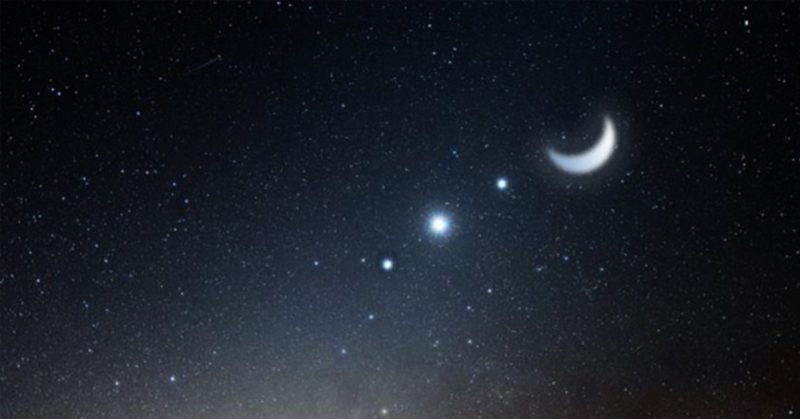If there was any time to seek cheer and positive vibes from the universe, it’s right about now. The world is going through scary times and people need to stay happy and motivated. What better rejuvenation than the sight of three planets lining up to grace the earth’s sky? It’s almost as though they are visiting an unwell sister planet to comfort and support her in a difficult time. The thought alone is pure magic to the mind.
Space scientists are alerting people of an exciting celestial event already happening: The line-up of Jupiter, Saturn, Mars and the crescent moon for the three consecutive days [1]. If you’re a fan of star-gazing, come out with your telescope or binoculars on April 14, 15, and 16 during the early dawn hours to catch the planet line-up. While April 14 has already passed, there are two more days left to enjoy the magical sight.
Planets occasionally navigate towards one another and can be seen in the earth’s sky. All through March, Jupiter, Saturn, and Mars could be seen away from each other at night – although they are morning planets and are seen more visibly in the morning sky. Mars is far less gaseous than the other two planets and has been gravitating away from them, but during these three days in mid-April, they will be close together in a line-up with the crescent moon. It will probably be a couple of years before this phenomenon occurs again, so try not to miss this one.
What to expect?
The planets will appear in the sky like extremely bright stars, so don’t expect to see the humanoid face of Mars, the gigantic size of Jupiter or the ring around Saturn. It’s all a matter of perspective since these celestial bodies are extremely far away from Earth. The revolving moon will be approximately 243,000 miles (390,000 kilometers) away from Earth when the phenomenon occurs, Mars will be 125 million miles (200 million km) away, Jupiter will be 473 million miles (761 million km) distant, and Saturn is the farthest out in the group, standing 936 million miles (1.51 billion km) away from the earth [2].
The viewing times are: April 14 – 3 am; April 15 – 3.30 am; April 16th – 4 am.
If you’re unable to spot the planets from your location, you could use stargazing apps to follow up on this rare treat because they won’t come together again until mid-2022.
Jupiter is a large star that glows pure white and is the second brightest point of light in the night sky. Saturn has a faint yellowish color. Mars is a distinct red star visible even to the unaided eye (it’s called the red planet due to an abundance of iron oxide).
These days, star-gazing is one of the best things you could do to clear your mind as well as your body. Due to the COVID-9 lockdown protocols, the environment has witnessed a drop in pollution which leaves and the air far fresher [3]. Despite the grim circumstances, cleaner air could help clear your mind and enrich the soul while we hope for better days.
Depending on your location on earth, you get to see a few of the planets (including Venus) at varying times of the year in the night and morning sky. Even when the other planets are no longer visible, Venus still has Earth’s back. She’s been appearing every night since early March. Venus has often been mistaken for a UFO because she’s a large silver star soaring gently in the sky, shining brighter than any star ever could.
References
- “Rare Event: Mars, Saturn, Jupiter, Moon To Line Up On These 3 April Nights, Here’s How To Watch.” India Times. Shreya Chuahan. Retrieved April 15, 2020.
- “You can see the moon shine with Jupiter, Saturn and Mars before dawn this week. Here’s how.” Space.com. Joe Rao. Retrieved April 15, 2020.
- “The Best Free Stargazing Apps Of 2018.” Forbes. Jesse Shanahan. Retrieved April 15, 2020.
- “‘It’s positively alpine!’: Disbelief in big cities as air pollution falls.” The Guardian. Ellis-Petersen. Retrieved April 15, 2020.

